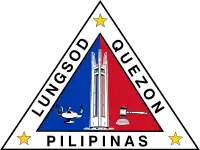City of Greater Manila
The City of Greater Manila, also known simply as Greater Manila and sometimes Greater Manila Area (GMA),[1] was a chartered city[2] which existed during the Japanese occupation of the Philippines in World War II era. It was governed by the Commonwealth of the Philippines. It served as a model for the present-day Metro Manila and the administrative functions of the Governor of Metro Manila, both established three decades later during the administration of President Ferdinand Marcos.
| City of Greater Manila | |||||||||||||
|---|---|---|---|---|---|---|---|---|---|---|---|---|---|
| Chartered city of the Philippines | |||||||||||||
| 1942–1945 | |||||||||||||
 Location of the historical city of Greater Manila. | |||||||||||||
| History | |||||||||||||
| Government | |||||||||||||
| Mayor | |||||||||||||
• December 24, 1941 – January 26, 1942 | Jorge B. Vargas | ||||||||||||
• January 27, 1942 – July 17, 1944 | León Guinto | ||||||||||||
| Historical era | World War II | ||||||||||||
• Established | January 1, 1942 | ||||||||||||
• Disestablished | August 1, 1945 | ||||||||||||
| |||||||||||||
| Today part of | Metro Manila | ||||||||||||
Greater Manila was formed on January 1, 1942, by virtue of Executive Order No. 400 signed by President Manuel L. Quezon as an emergency measure. It was a merger of the cities of Manila and Quezon City and the then-Rizal towns of Caloocan, Makati, Mandaluyong, Parañaque, Pasay, and San Juan.[2][3][4][5] Jorge B. Vargas was appointed Mayor of the City of Greater Manila in December 1941. He then appointed León Guinto as his successor a month later, in January 1942.
Mayors of the towns and cities that comprised the City of Greater Manila became assistant mayors (equivalent to present-day vice mayors) of the consolidated city and were under the Mayor of the City of Greater Manila.[3][5] It was also represented in the National Assembly of the Japanese-sponsored Second Philippine Republic under the at-large district of Manila.
On July 26, 1945, President Sergio Osmeña signed Executive Order No. 58, which would reduce the territories and thus dissolve the City of Greater Manila. The order took effect six days later, on August 1. The cities and towns that were once part of the city then regained their respective pre-war status.[6]
See also
References
- "Chapter I". Quezon City at 75 Resurgent & Resilient. Erehwon Artworld Corporation for the Local Government of Quezon City through the Communications Coordination Center. 2014. p. 69. ISBN 9789719566632.
- Philippines (1942). "Chartered Cities". Official Gazette of the Republic of the Philippines. 1 (4): 200.
- Executive Order No. 400, s. 1942 (January 1, 1942). Creating the City of Greater Manila. Official Gazette of the Republic of the Philippines. Retrieved August 24, 2022.
- Map of the City of Manila (Map). 1:40,000. Division of Drafting and Surveys, Office of the City Engineer and Architect, City of Manila. 1942. Retrieved August 24, 2022.
- "Historical Background". DENR - Environment Management Bureau - National Capital Region. Retrieved May 28, 2022.
- Executive Order No. 58, s. 1945 (July 25, 1945). Reducing the Territory of the City of Greater Manila. Official Gazette of the Republic of the Philippines. Retrieved August 24, 2022.

